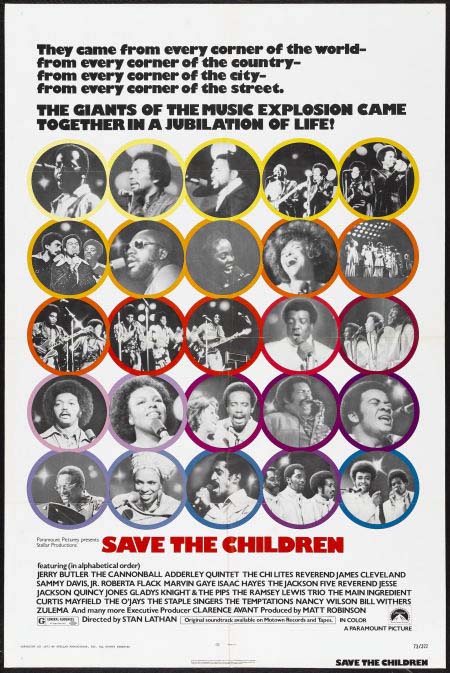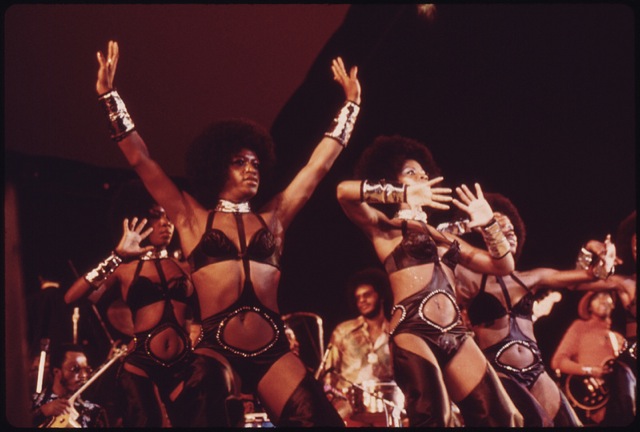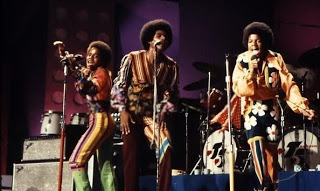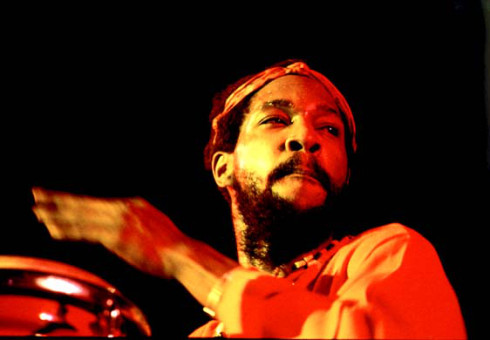
Good Morning POU!
Imagine this one concert: Marvin Gaye, the Staple Singers, the Temptations, the Chi Lites, the Main Ingredient, the O’Jays, Isaac Hayes, Zulema, the Rev. Jesse Jackson, the Cannonball Adderly Quintet, the Push Mass Choir, Albertina Walker, Loretta Oliver, the Rev. James Cleveland, Bill Withers, Curtis Mayfield, Sammy Davis Jr., Roberta Flack, Quincy Jones, Gladys Knight and the Pips, Jerry Butler, Brenda Lee Eager, the Ramsey Lewis Trio, Nancy Wilson, the Jackson Five, Jackie Verdell and Dick Gregory.
WOW!
Save The Children was a concert documentary that was filmed at the Operation PUSH Black Expo that took place from September 27 to October 1, 1972 at the Chicago Amphitheatre.
The movie, which was executive produced by music executive and entrepreneur Clarence Avant and directed by Stan Lathan, was released on September 18, 1973 through Paramount Pictures and had its gala premiere at the famed Apollo Theater.
Operation PUSH (People United to Save Humanity) was formed during the civil rights movement. When the Southern Christian Leadership Conference, or SCLC, targeted Chicago in 1965, the Reverend Jesse Jackson helped to formally organize Chicago ministers to promote more employment opportunities for local black people. This organization became known as Operation Breadbasket, and by the end of the 1960s it was the leading civil rights group in Chicago.
In 1971, Jackson left the SCLC and Operation Breadbasket became Operation PUSH. It pressured major companies to hire more blacks and to extend business ties with the black community.
Operation PUSH held its first Black Expo in 1971 and was a rousing success. It was so successful that the following year portions of Black Expo were filmed for a theatrical release.
The theme for 1972′s Black Expo was “Save The Children,” and footage of black children in inner city neighborhoods from around the country was shown throughout the film.
One of the moving segments of the film was when Rev. Jesse Jackson stood with a family from Mississippi which consisted of 11 children, and he emphasized the importance of watching over, protecting, educating and nurturing the children who will become future leaders. Many people in the audience were moved to tears during Jackson’s speech.
Black businesses and corporations such as Johnson Publications and Johnson Products Company set up vendor booths in the Chicago Amphitheatre to not only advertise and talk about their businesses, but to also offer employment opportunities. During the five day exposition, recording artists from all genres of black music came out in force to support the event, ranging from gospel, R&B, jazz and blues.
The cross section of artists included The Staple Singers, Chi-Lites, Ramsey Lewis, James Cleveland, Isaac Hayes, The Temptations, Curtis Mayfield, The Main Ingredient, Jackson 5, Cannonball Adderly, The O’Jays and Bill Withers. The movie also featured cameos from big names such as Richard Roundtree, Ossie Davis and Dick Gregory.
Many of the artists performed mini-concerts during their sets, but for the film’s running time, only one or two selected performances from each artists was shown. They were all dedicated in showing up for the worthy cause. For instance, jazz singer Nancy Wilson came out of a sick bed to go all the way to Chicago to give a rousing performance of “The Greatest Performance of My Life.” Superstar Sammy Davis Jr., who received a lot of disapproval from black people for being photographed clutching (many perceived it as hugging) then-President Richard Nixon, was booed by the audience when he first came on stage. Davis broke down in tears until Jesse Jackson had to come out and ask the audience to be polite, silent and show respect. That portion of the performance was not shown in the theatrical release, but Davis’ heartfelt speech and performance of his signature tune “I’ve Gotta Be Me” was included, which brought him a standing ovation. Davis told the audience, “Disagree with my politics, but you can’t take away the fact that I am black.”
Roberta Flack was sick during this period as well, but she showed up to perform a medley of “On A Clear Day You Can See Forever”/”Killer Joe” with Quincy Jones.
The Staple Singers had the Holy Ghost moving throughout the Chicago Amphitheatre during their performance of a rousing gospel number. Likewise, gospel singers James Cleveland, Albertina Walker and the PUSH Mass Choir stirred the audience with their gospel selections.
The biggest excitement came when The Jackson 5 appeared on stage. They did a full concert instead of a mini-set. After Soul Train host Don Cornelius’ introduction of them as “the mighty mighty Jackson 5,” kids and teenagers in the audience cheered and screamed and even rushed the stage as their musical idols appeared before them. To highlight the excitement of the group, a split screen effect was utilized during their fantastic performance of “I Wanna Be Where You Are,” which showed both the group singing and performing along with people in the audience dancing to the song.
Marvin Gaye, in one of his rare appearances, did three numbers from his classic What’s Going On album. He performed moving performances of “Save the Children” (which opens up the film), “What’s Happening Brother” and “What’s Going On.” Footage of the devastation during the ongoing Vietnam War was intercut with Gaye’s performance of the latter song, particularly startling footage of the children who were suffering in Vietnam and in Third World countries.
The soundtrack for the film was released on Motown Records seven long months after its theatrical release. The reason for this was that there were a lot of legal entanglements to get clearances to feature non-Motown artists on the soundtrack. As a result, several artists’ performances did not get on the soundtrack, including those by The Staple Singers and Isaac Hayes, both of whom were on Stax Records.
The entertaining but thought-provoking film is a soulful time capsule of great performances and performers, several of whom are no longer here, while showcasing the importance of saving black youth, a theme that is extremely relevant to this very day 40 years later.




